5 Social Media and Polarization
Dana Schowalter
Social Media and Polarization
We often hear that social media is making the U.S. and the world a more polarized place, where liberal and conservatives disagree more than ever before. And while social media has certainly contributed to polarization, this lesson aims to put the issue of social media and polarization into a larger context, both within the field of social media research and within the context of studying how our brains analyze messages we see and hear.
WHAT IS POLARIZATION?
Polarization is the idea that people are divided into two different subgroups on an issue they care about, and those two groups have conflicting and contracting views, goals, and opinions on the issue. Polarization is not just a minor disagreement. Instead, polarization says that the two groups have almost no middle ground—that people tend to have views that are on the extreme opposite ends with very little room for views that are somewhere in the middle. Additionally, polarization means there is very little bridging, which means there is almost no effort for people on either side to learn from the opposing group or to find ways to work more effectively together through their difference. Simply stating, polarization means the groups have formed in opposition to each other, and they don’t seem to be working toward coming together on the issue.
So, are we becoming more polarized? Studies show that we are.
First, we can see from public opinion polling that in general, more people are moving to the political extremes, and that fewer people label themselves as moderates or in the middle on the big political issues of the day. So, by this graph, we do tend to be getting more polarized politically.

Additionally, people in opposing camps (republicans and democrats) are also viewing the other “team” in increasingly negative ways. So, instead of just saying that the two sides differ on how to handle political issues, polling suggests that people tend to view the opposing side as different and WORSE than their own side. These polls from PEW Research, one of the most trusted polling organizations in the U.S., show that republicans and democrats view each other unfavorably, and apply terms like “lazy,” “dishonest,” and “unintelligent” to describe each other.
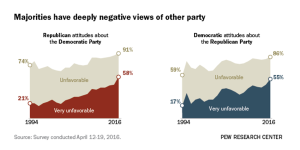
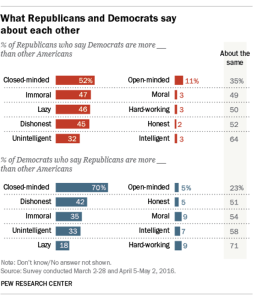
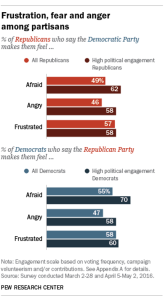
Social media companies also do a great deal of tracking on which issues people tend to talk about. This data shows that republicans and democrats are also talking about completely different issues and have fewer issues and interests in common than they have previously. So, that means that in addition to having different voting preferences, republicans and democrats also like and participate in different activities, listen to different music, wear different clothes, etc.
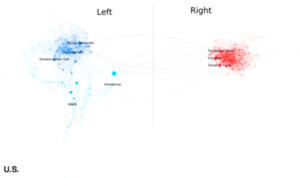
So yes, we are increasingly polarized, but the above definition.
But, it is also true that when you ask people in the United States how far apart we are on the issues, we do tend to overexaggerate how far apart we really are. So, when you ask republicans what the democrats think (and vice versa) our national policy on immigration should be, for example, and compare that to the actual positions of the political parties, you get charts that look something like this:
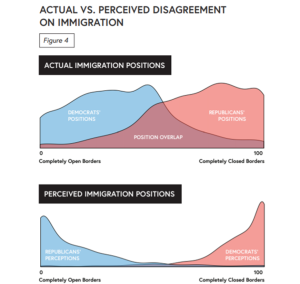
So the real answer is slightly more complicated. Let’s get into why.
CAUSES OF POLARIZATION:
Yes, we live in a society that is increasingly polarized, and yes, this polarization exists alongside a social media environment that is also polarized. But, many of the causes of polarization are not unique to social media. Many of the reasons we tend to have polarization in the first place are actually rooted in the way the brain processes information and in how we structure our society more generally. Here are a few of those factors:
- HOMOPHILY: This is the idea that people tend to seek out others who are similar to themselves. Humans do this all the time. We tend to group ourselves with people who group up similarly to us or who have similar lifestyles now. We have neighborhoods divided by race and class. So, in part, the polarization we see on social media is actually similar to the ways we tend to separate ourselves in other areas of our lives.
- CONFIRMATION BIAS: We tend to seek out information that confirms what we already know to be true, and we tend to ignore information that goes against our beliefs. So, if you are reading an article from a fact-checker, you are likely to pay more attention to the parts of the narrative that support your existing beliefs, and the parts that highlight why you might be wrong you tend to ignore.
- SELECTIVE EXPOSURE AND SELECTIVE RETENTION: Selective exposure is the ideas that when presented with the option of getting information from a variety of perspectives (for example, you could get the news from a website like Allsides.com, which gives you news from the left, right, and center on a number of big issues of the day), most people actively select articles from sources they know will include coverage that supports their point of view. Selective retention says that even if we read the news articles that challenge our viewpoints (which, again, we aren’t likely to do), we tend not to remember that information as readily as we remember the information that supports our point of view. It is almost as if we never read it, because we don’t retain it.
- BIASED ASSIMILATION: This is the idea that when we are doing research or reading articles on an issue, we tend to interpret that information in ways that supports our point of view. So, we tend to overexaggerate the importance of information that supports our viewpoint and repeat it to others as evidence that we are correct. We tend to undervalue or discount evidence that might mean we are wrong on an issue.
- GROUPTHINK: This is when a group of people think similarly about an issue. When everyone agrees, no one is there to contradict the group, so the whole group continues their thought process without being intellectually challenged. Groupthink occurs when that group that only includes voices of agreement then starts to spiral, going further and further into the belief. When they aren’t challenged, they aren’t being asked to evaluate evidence or justify their positions, so instead they tend to believe strongly in their ideas and are more likely to become polarized.
- MEDIA BIAS: The media are also biased, both social media and traditional news outlets. The AllSides.com link above is a great place to go for indepth information about how news bias makes its way into articles and information about events.
SO WHERE DOES SOCIAL MEDIA COME IN?
The list above highlights that bias and polarization is part of the human experience, and has and would continue to exist even without social media. But, social media is also part of the equation, so in this section we will explore the ways that social media tends to exacerbate the issues listed above.
FILTER BUBBLES AND ECHO CHAMBERS:
Filter bubbles and echo chambers are two huge features of social media polarization. Here is a video that explains what a filter bubble is and why it matters for our political landscape:
A filter bubble means the algorithm only exposes you to content it has determined you will like and that will keep you on the site or app longer. An echo chamber, in comparison, is when you choose to continue to surround yourself with information and content that is ideologically pleasing. The filter bubble is something the algorithm does largely without us knowing it is happening. The echo chamber is something we often choose through our actions, and when we choose to only be exposed to information that is pleasing to us and that does not challenge our ideas, we are more likely to be critical of or ignore people and ideas that are different.
These issues are summed up in this video, which gives concrete examples of how social media and real life polarization is impacting the political landscape.
INFORMATION OVERLOAD:
Social media exposes us to more information and more quickly than ever before. When we are exposed to more information than we could possible get through in the time we have, research shows us that we tend to read the most agreeable information first. We tend to avoid reading information that conflicts with our viewpoints, even when we would technically have time to read those articles. As we click repeatedly on articles that reinforce our ideas and gloss over articles that do no, the social media algorithms are designed to use that feedback to filter out content that we are not using in order to reduce information overload. That means that social media aids in homophily (grouping us with other like-minded people) and groupthink (grouping us with like-minded people to the extent that our ideas are not challenged and become more extreme).
SELECTIVE EXPOSURE ON SOCIAL MEDIA:
One study of 1020 social media users asked people to pick a news article to read from one of four headlines: one from FOX, CNN, NPR, and BBC. They found that users tended to select news based on what they thought they would agree with already. So, while social media and online news articles actually give us access to more information than ever before, we tend to select information that reinforces what we already think to be true.
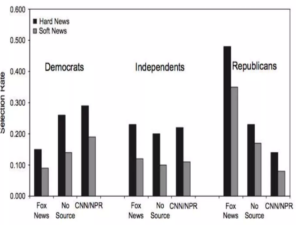
This is also true for blogs. A study of how people used blogs during the 2004 election showed strong evidence that selective exposure was a key issue. Almost 95% of participants read only blogs that confirmed their point of view. The blogs also reinforced this: most of the evidence for the positions in the blogs came from links to other blogs or news written from the same point of view (so, conservative blogs used other conservative blog posts as evidence, and liberal blogs used other liberal blogs as evidence). This led researchers to conclude that selective exposure and polarization is greater for blog readers than TV watchers.
Another study looked at Facebook users who had expressed a political affiliation in their bio information. Researchers then altered the feed to control for what the feed would look like if the algorithm were removed and the feed was unfiltered, and they compared that to the feed with the algorithm. They found that even if they removed the filtering of the algorithm, people tended to have social norms that reinforced polarization. Democrats tended to have mostly other democrats as friends. Republicans tended to have mostly other republicans as friends. Because of that, even without the algorithm, people’s news feeds tended to be relatively homogenous, exposing them mostly to information shared that confirmed the point of view they already had. In many cases, the social structures of participants lives were actually stronger predictors of filtering than the algorithm. This also leads to biased sharing and biased assimilation.
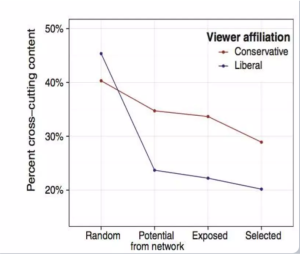
We also know that our identities play a huge role in polarization. For many people, their social worlds and the way they use the political stances to reinforce their identities plays a huge part in what we share and how we interpret the things other people share. Check out this video that explains how this works and why it matters:
Studies also show that because of the ways we self-segregate, people on opposite sides of the political spectrum have very little in common with each other. As I mentioned, people tend to talk about different issues, listen to different music, etc. This graph highlights how republicans (the red dots) and democrats (the blue dots) use political hashtags.
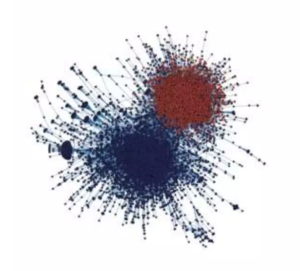
As you can see, the majority of the time, our tweets and hashtags are echo chambers, in that the only people who really interact with our content tend to be people we already agree with. This is especially true in Twitter/X, where users tend to self-practice homophily by following and retweeting accounts they already tend to agree with.
SO, HOW DO WE FIX POLARIZATION?
Well, first of all, we can ask whether we want to fix this polarization. I can’t answer this question for you. Some people say yes, that we need to fix this problem in order to save our democracy. Other people say no, because they generally feel unsafe around people whose viewpoints differ from theirs.
Second, it is difficult, but not impossible to do. For starters, as mentioned in the lesson, people on opposite sides of an issue that is experiencing polarization tend to not have very many shared interests. So, they don’t often expose themselves to each other, or even to the same cultural artifacts. For example, how can we bridge the divide between these two users? Is exposing them to the same content enough?

Evidence suggests that the most effective way to fix polarization is to:
- Form friendships across the political spectrum.
- Expose yourself to content that challenges your believes. Here are some good places to get started in exploring what types of content you are being exposed to now.
- com
- Wall Street Journal Red Feed Blue Feed
- NYTimes: Right and Left
- Escape Your Bubble or Flip Feed browser extensions

